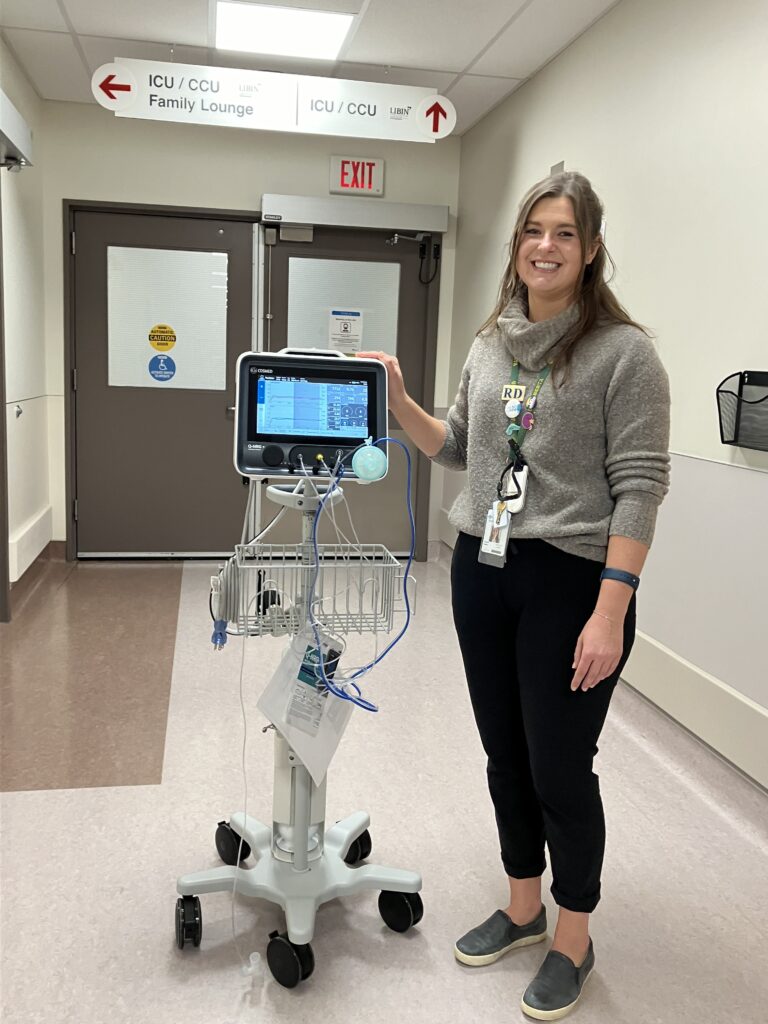South Health Campus staff excited to receive new Q-NRG Indirect Calorimeter.

When a patient is in the Intensive Care Unit (ICU), they are fighting for their lives. While we often think about the nurses and doctors in the ICU helping to keep that patient alive, other hospital staff who are also an important part of that journey frequently fly under the radar—one of these is dietitians.
Dietitians play a crucial role in treating ICU patients. When patients are in ICU, their bodies are under significant stress, and when someone is critically ill, they burn more energy and lose more muscle mass. Losing muscle mass means that hormones and immune systems don’t work the same, and the chances of getting an infection become much greater.
To reduce stress on the body while in ICU, it is important that patients receive the right amount of calories, fat, carbohydrates, and proteins.
Thanks to the generosity of our donors, each of the adult acute care sites in Calgary—South Health Campus, Rockyview General Hospital, Foothills Medical Center, and Peter Lougheed Centre—have received a Q-NRG.
The Q-NRG is an indirect calorimeter. This means the device measures oxygen taken in and carbon dioxide expelled during a breath to calculate how much energy a patient is using in a resting state, and therefore how many calories they need. Through the Q-NRG, dietitians can determine if a patient is burning more fat, carbohydrates, proteins, or a mix of those, and therefore tell if the patient is being over or underfed.
As South Health Campus ICU dietitian Sydney Bieleny explains, “In the past, we didn’t have accurate ways to determine the caloric needs of different patients. We know that over or under-feeding a patient in the ICU can result in very significant setbacks for that patient. To be able to have the precision that this piece of equipment offers is phenomenal.”
The Q-NRG is particularly useful for unique patient populations, including those with higher body weights and those who are malnourished, which make up a substantial proportion of ICU patients.
The unique thing about this specific device is that it can also be used on patients who aren’t intubated. This means that it can be used in units across the hospital, not just the ICU.
The impacts of having the new Q-NRG devices are substantial for staff, patients, and families. Compared to the previous device, the Q-NRG offers much quicker results, taking only about 10-20 minutes compared to the previous 24 hours that was needed to produce a similar test result. In addition to being much faster, the Q-NRG is also less invasive, as patients previously had to be hooked up to the old device for the full 24 hours until the testing was complete. Finally, the test results are far more accurate—within 45 calories plus or minus.
Sydney sees other benefits of this new device as well: “It is so simple to use, making it easier for us to test and see more patients. This device means better care for patients. By making sure their body has the energy it needs, patient recovery times are faster, and their chances of infection are reduced, potentially resulting in shorter lengths of stay.”
It was through the support of our donors that we were able to provide these important devices to each of the adult acute care sites in Calgary. Your generous support ensures more firsts, like Q-NRG devices, for healthcare in Calgary.


